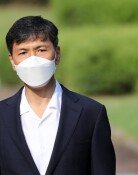Gov`t allows 1st public look at rare isotope accelerator
Gov`t allows 1st public look at rare isotope accelerator
Posted April. 22, 2011 03:18,
A birds eye view of the International Science Business Belts Korea Rare Isotope Accelerator (KoRia) has been made public for the first time.
The accelerator, the belts lone large-scale experiment facility, consists of a cyclotron 10 meters in diameter, a linear accelerator 700 meters long, an experiment building and a research building, among others, built on a site covering 1.08 square kilometers. The cyclotron and the linear accelerator will be installed some 10 meters underground.
According to the final report for the conceptual design of the KoRIA exclusively obtained by The Dong-A Ilbo, the cyclotron accelerates protons at 70 kilowatts while the linear accelerator speeds up heavy ions such as uranium at 40 kilowatts. One of the most salient features of the KoRIA is that the cyclotron and the linear accelerator are connected, allowing scientists to obtain very rare isotopes by making rare isotopes created by the cyclotron collide in the linear accelerator.
Among some 20 heavy ion accelerators being operated or built in the world, such a rare isotope accelerator is unique with KoRIA. The more rare isotopes that a heavy isotope accelerator creates by colliding heavy isotopes accelerated in a vacuum, the higher research value it can create.
KoRIA can also accelerate all heavy ions in the periodic table of elements from the protons of hydrogen to those of uranium.
If a scientist finds a new isotope through the accelerator, it could mean the Nobel Physics Prize. Of the 101 Nobel laureates in physics, about 20 percent are related to accelerators.
Japan discovered a new particle in 2004 by using a heavy isotope accelerator, naming it japonium and registering it on the periodic table with element number 113. With the new device, Korean scientists can also find a new element.
The Korean Education, Science and Technology Ministry`s task force on the science and business belt completed a 700-page final report on the complex, whose main points include the KoRIA. Based on the report, the ministry will implement the next phase of the project to build the accelerator.
This year, the ministry plans to make a preliminary detail design. It had reportedly planned to make a detailed design this year but decided to go through a preliminary detail design process, accepting the evaluators view that the concept design should be complemented.
A ministry official said a budget of 4 billion won (3.7 million U.S. dollars) will go to holding a public competition for the preliminary detail design.
Due to the additional process, the planned completion of KoRIA has been delayed for two years until 2018. According to the final report, evaluation committee members said the original completion date of 2016 is impossible considering the length of time needed for the detailed design and technological development.
The ministry will also launch a KoRIA task force late this year to speed up construction of the accelerator.
uneasy75@donga.com







